Spatial Distribution of the Cannabinoid Type 1 and Capsaicin Receptors May Contribute to the Complexity of Their Crosstalk
- PMID: 27653550
- PMCID: PMC5032030
- DOI: 10.1038/srep33307
Spatial Distribution of the Cannabinoid Type 1 and Capsaicin Receptors May Contribute to the Complexity of Their Crosstalk
Abstract
The cannabinoid type 1 (CB1) receptor and the capsaicin receptor (TRPV1) exhibit co-expression and complex, but largely unknown, functional interactions in a sub-population of primary sensory neurons (PSN). We report that PSN co-expressing CB1 receptor and TRPV1 form two distinct sub-populations based on their pharmacological properties, which could be due to the distribution pattern of the two receptors. Pharmacologically, neurons respond either only to capsaicin (COR neurons) or to both capsaicin and the endogenous TRPV1 and CB1 receptor ligand anandamide (ACR neurons). Blocking or deleting the CB1 receptor only reduces both anandamide- and capsaicin-evoked responses in ACR neurons. Deleting the CB1 receptor also reduces the proportion of ACR neurons without any effect on the overall number of capsaicin-responding cells. Regarding the distribution pattern of the two receptors, neurons express CB1 and TRPV1 receptors either isolated in low densities or in close proximity with medium/high densities. We suggest that spatial distribution of the CB1 receptor and TRPV1 contributes to the complexity of their functional interaction.
Figures
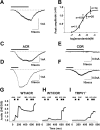


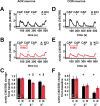

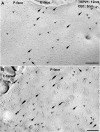
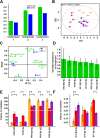
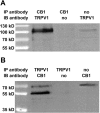
Similar articles
-
The endogenous cannabinoid anandamide inhibits transient receptor potential vanilloid type 1 receptor-mediated currents in rat cultured primary sensory neurons.Acta Physiol Hung. 2010 Jun;97(2):149-58. doi: 10.1556/APhysiol.97.2010.2.1. Acta Physiol Hung. 2010. PMID: 20511124
-
TRPV1, TRPA1, and CB1 in the isolated vagus nerve--axonal chemosensitivity and control of neuropeptide release.Neuropeptides. 2011 Dec;45(6):391-400. doi: 10.1016/j.npep.2011.07.011. Epub 2011 Aug 24. Neuropeptides. 2011. PMID: 21868092
-
Effects of cannabinoids on capsaicin receptor activity following exposure of primary sensory neurons to inflammatory mediators.Life Sci. 2010 Jul 31;87(5-6):162-8. doi: 10.1016/j.lfs.2010.06.003. Epub 2010 Jun 17. Life Sci. 2010. PMID: 20598325
-
Inhibitory CB1 and activating/desensitizing TRPV1-mediated cannabinoid actions on CGRP release in rodent skin.Neuropeptides. 2011 Jun;45(3):229-37. doi: 10.1016/j.npep.2011.03.005. Epub 2011 Apr 22. Neuropeptides. 2011. PMID: 21514666
-
Capsaicin, transient receptor potential (TRP) protein subfamilies and the particular relationship between capsaicin receptors and small primary sensory neurons.Anat Sci Int. 2006 Sep;81(3):135-55. doi: 10.1111/j.1447-073X.2006.00141.x. Anat Sci Int. 2006. PMID: 16955665 Review.
Cited by
-
Brain permeant and impermeant inhibitors of fatty-acid amide hydrolase suppress the development and maintenance of paclitaxel-induced neuropathic pain without producing tolerance or physical dependence in vivo and synergize with paclitaxel to reduce tumor cell line viability in vitro.Pharmacol Res. 2019 Apr;142:267-282. doi: 10.1016/j.phrs.2019.02.002. Epub 2019 Feb 7. Pharmacol Res. 2019. PMID: 30739035 Free PMC article.
-
Cannabinoids and the endocannabinoid system in the regulation of cytochrome P450 metabolic activity-a review.Front Pharmacol. 2025 Jun 5;16:1599012. doi: 10.3389/fphar.2025.1599012. eCollection 2025. Front Pharmacol. 2025. PMID: 40538541 Free PMC article. Review.
-
TRP Channels as Novel Targets for Endogenous Ligands: Focus on Endocannabinoids and Nociceptive Signalling.Curr Neuropharmacol. 2018 Jan 30;16(2):137-150. doi: 10.2174/1570159X15666170424120802. Curr Neuropharmacol. 2018. PMID: 28440188 Free PMC article. Review.
-
Role of N-Arachidonoyl-Serotonin (AA-5-HT) in Sleep-Wake Cycle Architecture, Sleep Homeostasis, and Neurotransmitters Regulation.Front Mol Neurosci. 2017 May 30;10:152. doi: 10.3389/fnmol.2017.00152. eCollection 2017. Front Mol Neurosci. 2017. PMID: 28611585 Free PMC article.
-
20:4-NAPE induced changes of mechanical sensitivity and DRG neurons excitability are concentration dependent and mediated via NAPE-PLD.Sci Rep. 2025 Apr 23;15(1):14131. doi: 10.1038/s41598-025-98567-y. Sci Rep. 2025. PMID: 40269193 Free PMC article.
References
-
- Devane W. A. et al.. Isolation and structure of a brain constituent that binds to the cannabinoid receptor. Science 258, 1946–1949 (1992). - PubMed
-
- Nagy I., Friston D., Valente J. S., Torres Perez J. V. & Andreou A. P. Pharmacology of the capsaicin receptor, transient receptor potential vanilloid type-1 ion channel. Progress in drug research. Fortschritte der Arzneimittelforschung. Progres des recherches pharmaceutiques 68, 39–76 (2014). - PubMed
-
- Mezey E. et al.. Distribution of mRNA for vanilloid receptor subtype 1 (VR1), and VR1-like immunoreactivity, in the central nervous system of the rat and human. Proceedings of the National Academy of Sciences of the United States of America 97, 3655–3660, 10.1073/pnas.060496197 (2000). - DOI - PMC - PubMed
LinkOut - more resources
Full Text Sources
Other Literature Sources

